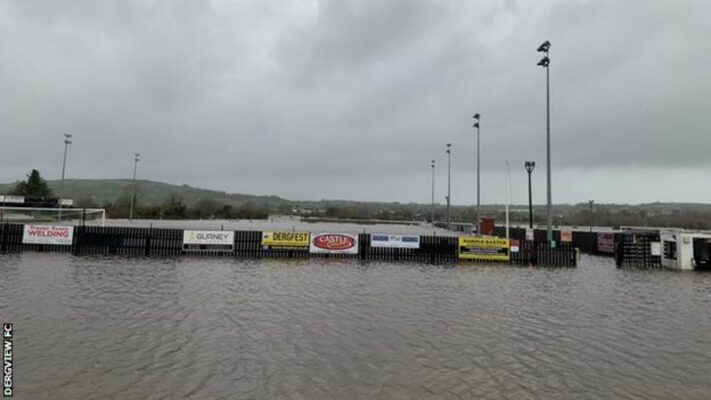
Dergview pitch submerged in water as a result of Storm Franklin
The Darragh Park pitch and training pitch are under “one or two metres” of water after several storms.
In a message on its Facebook page, the club say: “Melting hill snow and several storms later severe flooding has hit the Derg valley.
“Roads, homes, business premises and unfortunately our grounds have all been affected.
“Until the floods subside we will be unable to assess the damage this has caused but with a weather warning still in place the worst may not have yet arrived.
“Please DO NOT ENTER the grounds!”
Manager Tommy Canning says the flooding of Darragh Park highlights the issue in the delay of stadia funding in the North of Ireland.
The Stormont Executive committed £36m for sub-regional stadia funding in 2015 but that money has yet to be released.
Dergview’s pitch and training pitch are under “one or two metres” of water after several storms.
“When things like this happen you worry about it happening again and again,” said Canning.
“How many times would you get away with it before you face a situation where your ground would no longer be viable?”
Following the collapse of the Executive at Stormont, Communities Minister Deirdre Hargey has met with the Northern Ireland Football League and the Irish FA to discuss the sub-regional stadiums funding plan.
The minister said earlier this week the funding has not been shelved and her department’s proposal is “ready to go” and is ready to “progress this project to the next stage”.
The delay has been widely criticised in the local football community and Canning believes the heavy flooding at Darragh Park is a stark example of why the funding is required.
“You would think that football clubs like Dergview would be high up the list of priorities to need financial assistance to stave off the threat of a football club losing its complete home ground,” he added.
“I think there is a bit of rhetoric around ‘why do you need money when you can spend ‘x’ amount of money on a player?’, and that has shifted the focus somewhat from the reality of the situations that clubs like Dergview are facing.”
With alarming pictures of Darragh Park submerged, comparisons have been made to fellow Championship club Institute, who were forced from their Riverside Ground after flooding in 2017 after Japanese Knotweed developed and facilities were heavily damaged.
“The worry is, you look at clubs like Institute and the difficulties they continue to face,” added Canning.
“There is a real need for improvement of infrastructure. This is a real-life example. We had two serious-enough storms, but there hasn’t been a huge amount of rain and it looks like it has done a serious amount of damage.
“The stadia funding is huge in the sense that the funding comes from the department of communities, and Dergview is a cross-community club and we are situated right on the border, so it gathers a lot of community focus.
“Hopefully that is not lost in the current stalemate.”
Too early to assess damage
Canning added it was too early to say the damage caused after the River Derg burst its banks.
Darragh Park had previously flooded in August 2016 but that was due to flash flooding after “a freak amount of rain” rather than issues from the neighbouring river.
“That disappeared as quickly as it came, but this is more worrying because it is a situation where a river has burst its bank,” added Canning about the flood in 2016.
“We’re in wet season and the forecast is not great, so it looks like this is going to cause more damage.”
Dergview invested in improving the surface at Darragh Park in pre-season last year and a training pitch was set to be used for the first time later in spring but is also heavily submerged.
“The worry is that all of the good work that has went on will be lost,” he added on the training pitch.
“There could be huge financial loss in terms of that, but it is hard to assess the damage at the minute.
“Lucky enough it hasn’t entered the club house, although it has come very close to it. It’s hard to assess the complete damage but there is stuff floating about everywhere up there.”
Tags:




